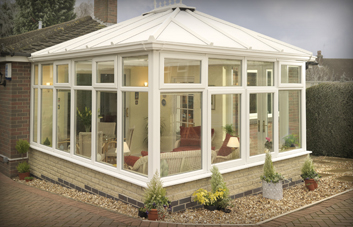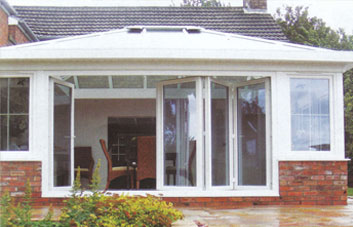

Conservatories
 We believe that choosing a conservatory should be a simple process.
We believe that choosing a conservatory should be a simple process.
Designing the right conservatory for you is one of the most important parts; there are many different types of conservatories to choose from including contemporary conservatories, hardwood conservatories, aluminium conservatories, summer houses, pool enclosures and garden rooms.
When the design is in place we can help you choose the right material. We offer the choice of hardwood, aluminium, or pvc or a combinations of any of these materials.
- Think about the intended use
How do you envisage using your new conservatory? Will be it a playroom, a dining area, an office, a second living room or an all year round, all weather extension to the garden? Its purpose doesn’t have to fit exclusively into one of these categories, but your conservatory’s ultimate day-to-day use will determine how large it needs to be as well which style, layout and materials will work best.
- Design and Quotation
Make sure that you receive detailed designs and quotation listing all the specification; don’t be afraid to ask for the quotation breaking down so you can see how the price has been put together.
- Don’t automatically go for the cheapest choice.
With conservatories, you tend to get what you pay for. As such, don’t automatically go for the ‘cheapest’ company unless its products and services also happen to be better than the competition. Another important factor to consider when appointing your installer should be their ability to meet your timescales. The last thing you want is an installation that will drag on and on, leaving your home looking like a building site for weeks or even months.
- Choose your materials wisely.
The materials that make up your conservatory will have an enormous effect on its lifespan, practicality and usage. Frames tend to be PVCu for lasting performance and glazing can now be polycarbonate, clear glass or performance glass. Choose materials that are easy to clean and maintain – you’ll be thankful for this in the long-term. Bases are typically built in stone or brick; ensure your builder can match to your existing brickwork.
- Think about the position.
Bear in mind the aspect – or position – of your conservatory. Conservatories that face south receive more sun than those facing north and as such the need for adequate ventilation and blinds is of uppermost importance. To help you regulate the temperature in a south facing conservatory, you might also want to think about using Celsius performance glass in the roof.
- Size matters
Once you’ve decided on the design and size of your new conservatory, get a second opinion from a friend or family member. Make sure your choice complements your home and has enough internal floor space to meets your requirements. In short, treat it as a fluid extension to your home rather than just an add-on.
- Consider your glazing options.
Carefully think about the type of glazing you’d like to use in your conservatory. Normal glass and polycarbonate will allow solar heat to penetrate into your conservatory, potentially making the inside temperature hot summer days. To avoid this ‘greenhouse’ effect, whilst reducing heat loss in winter, opt for a performance glass such as Celsius Plus or a polycarbonate with a solar reflective insert.
- Ventilation, ventilation, ventilation.
To help prevent the build of condensation in your conservatory, you need to ensure it has adequate ventilation. The Ultraframe roof vent lets fresh air in whilst keeping the elements and insects out. As an alternative, you could also consider roof fans or an air conditioning unit if your budget will stretch to it.
- Check with your local authority.
If you’re building a conservatory in England or Wales, you will not usually need planning permission (unless your property is listed, in a conservation area or it has already been extended). However it is always better to be safe than sorry. If you’re in any doubt, check as early as you can with your local authority or your chosen installer about this and any relevant building regulations.
- Call on the professionals.
Finally, always get your conservatory professionally designed and installed. Also be sure to use vetted installers who offer an insurance backed guarantee. With such a major and prized investment, it’s simply not worth taking the risk!
Examples of Conservatories
 |
 |
 |
 |
 |
 |
 |
 |
 |
 |
 |
 |
